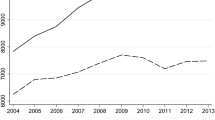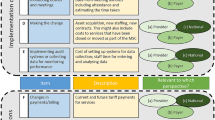Abstract
The UK Government has introduced a new class of health service providers called Treatment Centres that provide routine elective services but that do not deal with emergency cases or non-routine elective patients. The introduction of these centres provides a possible mechanism for improving the efficiency of service delivery in terms of overall capacity requirements. In this paper we discuss a mathematical modelling approach that has been used to examine circumstances under which such benefits might be realised. As an illustration of the analysis, we present results obtained using data concerning urological services, for which there would seem to be benefits associated with the introduction of a TC in only a limited range of circumstances.


Similar content being viewed by others
References
UK Department of Health (2000) The NHS plan: a plan for investment, a plan for reform, UK Department of Health, http://www.doh.gov.uk/nhsplan
P. Bate, J. Gabbay, S. Gallivan, M. Jit, A. le May, C. Pope, G. Robert, M. Utley (2007) The development and implementation of NHS treatment centres as an organisational innovation. NHS Service Delivery and Organisation Research Programme, UK Department of Health
Gallivan S, Utley M, Treasure T, Valencia O (2002) Booked in patient admissions and capacity. Br Med J 324:280–82
Utley M, Gallivan S, Treasure T, Valencia O (2003) Analytical methods for calculating the capacity required to operate an effective booked admissions policy for elective inpatient services. Health Care Manage Sci 6:97–104
Bagust A, Place M, Posnett JW (1999) Dynamics of bed use in accommodating emergency admissions: stochastic simulation model. Br Med J 319:155–58
Bowers J, Mould G (2002) Concentration and the variability of orthopaedic demand. J Oper Res Soc 53:203–210
Harper PR, Shahani AK (2002) Modelling for the planning and management of bed capacities in hospitals. J Oper Res Soc 53:11–18
Gorunescu F, McClean SI, Millard PH (2002) A queueing model for bed-occupancy management and planning of hospitals. J Oper Res Soc 53:19–24
Millard PH, Mackay M, Vasilakis C, Christodoulou G (2000) Measuring and modelling surgical bed usage. Ann R Coll Surg Engl 82:75–82
Gallivan S, Utley M (2005) Modelling admissions booking of elective in-patients into a treatment centre. IMA J Manag Math 16:305–315
Michaelis L, Menten M (1913) The kinetics of invertase activity. Biochemische Zeitschrift 49:333
UK Department of Health (2005) Hospital episode statistics, England 2000/1–2003/4. UK Department of Health
Wolfram Research Inc. (2000) Mathematica, version 4.1, Champaign, IL
Utley M, Gallivan S, Jit M (2005) How to take variability into account when planning the capacity for a new hospital unit. In: Vissers J, Beech R (eds) Health operations management. Routledge, New York, pp 146–161
Peters M, Pagel C, Gallivan S (2007) PICASSO—a computerised model of bed-demand in a paediatric intensive care unit. Paediatr Crit Care Med 8:A207
Bowers J, Mould G (2004) Managing uncertainty in orthopaedic trauma theatres. Eur J Oper Res 154:599–608
Acknowledgements
The Clinical Operational Research Unit receives funding from the UK Department of Health. This work was partly funded by the UK Department of Health NHS Service Delivery and Organisation programme. We would like to thank the referees for their helpful comments.
Author information
Authors and Affiliations
Corresponding author
Rights and permissions
About this article
Cite this article
Utley, M., Jit, M. & Gallivan, S. Restructuring routine elective services to reduce overall capacity requirements within a local health economy. Health Care Manage Sci 11, 240–247 (2008). https://doi.org/10.1007/s10729-007-9052-5
Received:
Accepted:
Published:
Issue Date:
DOI: https://doi.org/10.1007/s10729-007-9052-5




